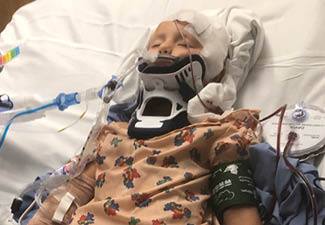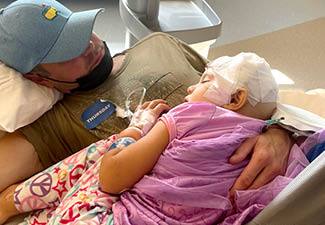
Livia Mayberry and her sister were playing basketball with their dad at a neighbor's house in August 2022 when then-4-year-old Livia took a hard fall and hit her head on the pavement.
Her family wasn't too concerned because she seemed OK. She was talking, didn't lose consciousness and didn't have a bump. However, a short time later, she threw up.
Quick medical attention
Her parents decided to get her checked at the Emergency Department at Mayo Clinic Health System in Mankato, Minnesota, to be safe.
"She seemed fine," says John Mayberry, Livia's dad, of their initial reaction to her fall. "Now, of course, we're so glad we brought her in."
Manish Sharma, M.B.B.S., a neurosurgeon, commends the family for bringing Livia in for evaluation because it can be difficult for parents and family members to determine if a head injury is serious.
"Many patients with head trauma will talk afterward and may seem OK," says Dr. Sharma. "Unfortunately, about 1% will die within 24 hours from their injuries. These unfortunate patients can develop internal bleeding deep in the skull that can increase in volume rapidly and compress the underlying brain tissue. That's why it's critical to get all head injuries checked right away."
Dr. Sharma says that all head injuries need careful monitoring, and emergency medical attention is necessary if the person also experiences a headache, vomiting, nausea, seizure or weakness.
Race against time
While in the Emergency Department, the family learned that Livia's bump on the head was more severe than they initially thought. A CT scan showed a fractured skull bone in her temple, which was causing blood to pool over her brain and compressing her brain in the process.
Dr. Sharma immediately reviewed the images and discussed the need for a lifesaving operation with anesthesiologist David Stinson, M.D., and emergency medicine physician Jason Planas, M.D.
"We were concerned by the size of the bleeding and the degree of brain compression. An emergency craniotomy would be needed to save life and function," says Dr. Sharma.
A craniotomy is a surgery to open a section of the skull to relieve pressure, remove blood and, occasionally, repair part of the brain.
Time was of the essence in Livia's case. Usually, neurosurgery procedures for pediatric patients are performed at Mayo Clinic in Rochester. However, Livia couldn't be safely transported there because Mayo Clinic Ambulance Service helicopters were grounded due to weather. Fortunately, specialists who could handle her case were on scene.
"Our Emergency Department team had a bad feeling about her injuries and contacted us immediately, even before they knew the helicopters weren't flying," Dr. Sharma says.
While some patients could be transported by ground in those situations, Livia needed to get to an operating room sooner. "She wouldn't survive an ambulance ride to Rochester," says Dr. Sharma. "Although we were in our civilian clothes, we decided to rush this child to the OR and operate immediately."

Dr. Sharma performed a two-hour craniotomy surgery. He made a 6-inch incision along Livia's temple, drilling holes around the skull fracture to evacuate the blood and relieve pressure on the brain. The skull segment was replaced and secured with titanium plates.
Once that procedure was done, Livia was transferred on a ventilator in an induced coma to Radiology, where another CT scan confirmed that the bleeding on her brain had stopped, and her brain compression had been relieved. She was then transferred by ambulance to Mayo Clinic Hospital — Rochester, Saint Marys Campus.
After an overnight stay in the hospital, Livia was cleared to go home with her family the next day. Her brain was safe, and she didn't need any further surgery.

One year later
About 12 months after her accident, Livia and her dad visited the Mankato team that swung into action to help her. They said the operating team, nurses and Emergency Department staff did a great job.
John says Livia is doing well and has fully recovered from her fall. She recently started a second year of preschool and is learning to ride a bike. Her family says she has no lasting effects of her injury.
"Right, pumpkin?" says John while holding Livia, who has grown back a full head of blond hair.
"Right," Livia says.
Her dad says Livia has been completely herself since the injury. She's full of energy and thriving. He and Livia's mother are grateful for the care she received.
"Everyone was amazing," says John. "It was all a little bit of a blur, but everyone was so nice and took great care of her."
This article first published on the Mayo Clinic Health System blog.







